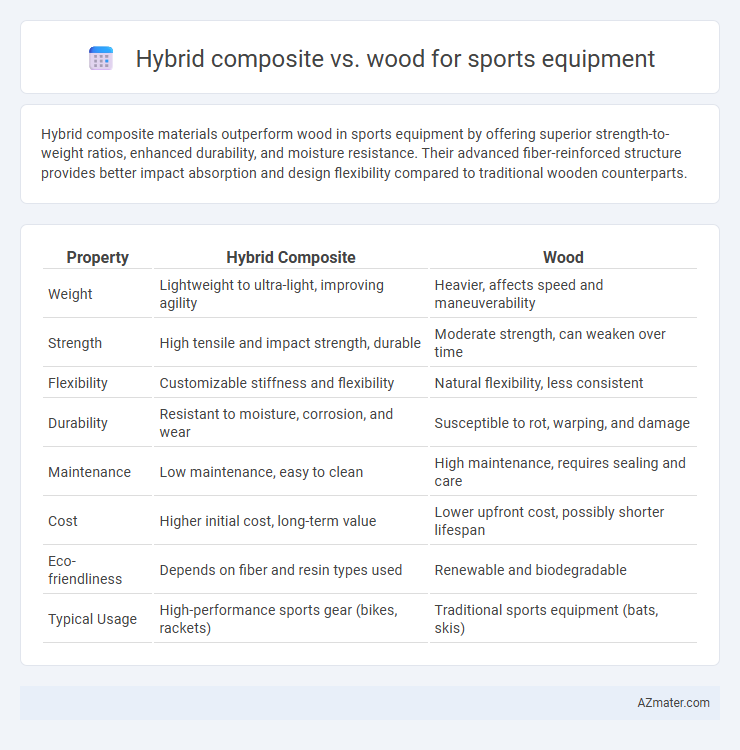Hybrid composite materials outperform wood in sports equipment by offering superior strength-to-weight ratios, enhanced durability, and moisture resistance. Their advanced fiber-reinforced structure provides better impact absorption and design flexibility compared to traditional wooden counterparts.
Table of Comparison
| Property | Hybrid Composite | Wood |
|---|---|---|
| Weight | Lightweight to ultra-light, improving agility | Heavier, affects speed and maneuverability |
| Strength | High tensile and impact strength, durable | Moderate strength, can weaken over time |
| Flexibility | Customizable stiffness and flexibility | Natural flexibility, less consistent |
| Durability | Resistant to moisture, corrosion, and wear | Susceptible to rot, warping, and damage |
| Maintenance | Low maintenance, easy to clean | High maintenance, requires sealing and care |
| Cost | Higher initial cost, long-term value | Lower upfront cost, possibly shorter lifespan |
| Eco-friendliness | Depends on fiber and resin types used | Renewable and biodegradable |
| Typical Usage | High-performance sports gear (bikes, rackets) | Traditional sports equipment (bats, skis) |
Introduction to Sports Equipment Materials
Hybrid composites combine fibers such as carbon or glass with resin matrices to offer superior strength-to-weight ratios and enhanced durability compared to traditional wood. Wood, historically used in sports equipment for its natural flexibility and shock absorption, is now often outperformed by hybrid composites in terms of performance consistency and resistance to environmental factors. The shift towards hybrid composite materials in sports gear like tennis rackets, hockey sticks, and bicycles reflects advancements in material science aiming to improve athletes' power, control, and endurance.
Defining Hybrid Composites and Wood
Hybrid composites combine multiple fiber reinforcements such as carbon, glass, or aramid fibers embedded in a resin matrix, offering superior strength-to-weight ratios and customizable performance characteristics ideal for high-impact sports equipment. Wood, a natural material primarily composed of cellulose fibers arranged in a lignin matrix, provides excellent shock absorption, flexibility, and traditional aesthetic appeal, commonly used in sports like baseball bats and hockey sticks. The choice between hybrid composites and wood hinges on factors like weight optimization, durability, and cost efficiency specific to the performance demands of different sports disciplines.
Mechanical Properties Comparison
Hybrid composites exhibit significantly higher tensile strength and stiffness compared to traditional wood, enhancing durability and performance in sports equipment under dynamic loads. The superior impact resistance and fatigue life of hybrid composites reduce the risk of material failure, making them ideal for high-stress applications like tennis rackets and hockey sticks. Wood, while offering natural flexibility and vibration damping, generally falls short in mechanical consistency and environmental resistance compared to engineered hybrid composites.
Durability and Longevity
Hybrid composites outperform wood in durability and longevity for sports equipment due to their superior resistance to moisture, impact, and wear. Materials such as carbon fiber-reinforced polymers maintain structural integrity and performance over extended use, unlike wood which is prone to warping, cracking, and degradation. This enhanced durability translates into longer-lasting equipment, reducing replacement frequency and improving value for athletes.
Weight and Performance Impact
Hybrid composites used in sports equipment offer significant weight reduction compared to traditional wood, enhancing athlete agility and reducing fatigue during extended use. These materials provide superior strength-to-weight ratios, resulting in improved impact resistance and durability under repetitive stress. Wood, while offering natural flexibility and vibration dampening, typically weighs more and can compromise performance consistency over time due to moisture absorption and wear.
Flexibility and Shock Absorption
Hybrid composite materials outperform traditional wood in sports equipment by offering superior flexibility and enhanced shock absorption properties. These composites combine fibers like carbon or fiberglass with resin matrices, resulting in a more resilient structure that adapts to dynamic stresses without compromising performance. This advanced material technology reduces vibrations and impact forces, improving athlete comfort and reducing injury risks compared to conventional wooden equipment.
Cost Efficiency and Accessibility
Hybrid composites for sports equipment offer superior cost efficiency by combining lightweight materials like carbon fiber and fiberglass, reducing manufacturing expenses over time due to durability and lower maintenance. Wood, while traditionally more accessible and cost-effective upfront, tends to incur higher replacement and repair costs because of susceptibility to wear and environmental damage. The balance between upfront cost and long-term value makes hybrid composites increasingly preferred for high-performance sports gear, though wood remains popular in budget-conscious or beginner markets.
Environmental and Sustainability Factors
Hybrid composites used in sports equipment offer enhanced durability and weight reduction compared to traditional wood, leading to longer product lifespans and less frequent replacements. The production of hybrid composites often involves recycled materials and lower emissions, reducing environmental impact relative to wood harvesting, which contributes to deforestation and habitat loss. Sustainable sourcing of raw materials and end-of-life recyclability further position hybrid composites as an eco-friendly alternative in the sports equipment industry.
Professional and Amateur Preferences
Hybrid composites offer superior strength-to-weight ratios and enhanced durability, making them the preferred choice for professional athletes seeking precision and performance in sports equipment such as tennis rackets and hockey sticks. Wood remains popular among amateurs for its natural feel, affordability, and ease of customization, providing a familiar response and shock absorption ideal for recreational play. Market trends indicate a growing shift toward hybrid composites in professional circles, while wooden equipment maintains a strong presence in grassroots and amateur sports communities.
Future Trends in Sports Equipment Materials
Hybrid composites offer superior strength-to-weight ratios and enhanced durability compared to traditional wood, making them increasingly favored in advanced sports equipment manufacturing. Innovations in nanomaterials and fiber-reinforced polymers are driving the evolution of hybrid composites, delivering greater performance and customization for athletes. Future trends suggest a growing integration of sustainable materials and smart composites equipped with sensors to provide real-time performance data.

Infographic: Hybrid composite vs Wood for Sports equipment
 azmater.com
azmater.com